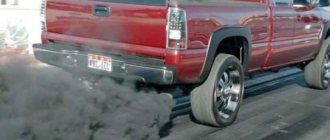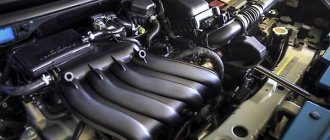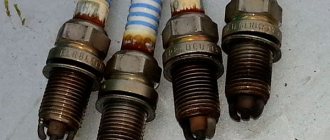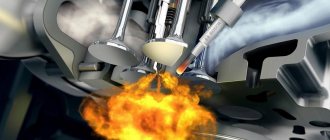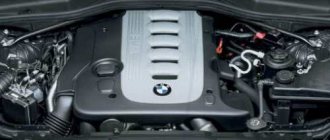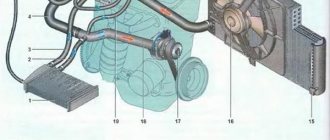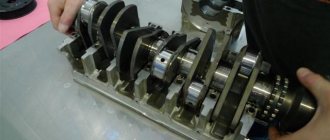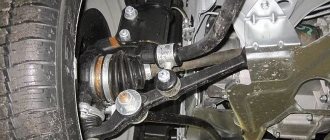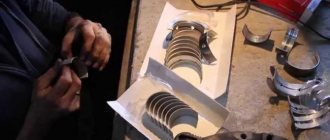A car smokes when cold, most often when the valve stem seals are worn, when piston rings are stuck, or when using an inappropriate viscosity or simply low-quality engine oil. For diesel engines, this can be a symptom of problems with the glow plugs, with the fuel system (high pressure pump) and occurs when using off-season diesel fuel.
| Situation | Cause of smoke when cold |
| Smokes when starting cold |
|
| Smokes when cold and then stops |
|
| Smokes white smoke when cold |
|
| Smokes blue when cold |
|
| Smokes black smoke when starting cold |
|
Main reasons
In such a situation, the presence of color in the exhaust indicates different engine conditions. Blue color means that oil has penetrated into the engine cylinder.
Increased fuel consumption contributes to this situation.
- Often blue signals a malfunction of parts in the cylinders or pistons.
- During the inspection, it is important to check the areas directly adjacent to the cylinder.
- You also need to check the side planes and depths of the rings on the pistons.
- Difficulties here arise due to the sealing of the cracks, which is caused by too much oil entering the system.
A little contamination does not cause a noticeable failure of compression, but you will need to exclude this possibility if a thick bluish exhaust is detected.
The color scheme of white and blue in connection with excessive fuel consumption can also be a symptom of a violation of the tightness of the valves and breakdowns in the ignition. New cars produce such smoke, but it gradually disappears, then there is no need to worry.
Why is oil intensively consumed?
In a working engine, valve stem seals and rings are responsible for removing residual lubricant from the valve stem and cylinder walls, respectively. At high speeds, the performance of this process decreases, but in general, oil consumption does not exceed the norm prescribed by the manufacturer. For some it is 1 l/10,000 km, for others it is 0.3 l/10,000 km, and still others may not add anything at all between service intervals, since they do not turn the engine above 3,500 rpm.
Naturally, when lubricant consumption suddenly increases, say, to 1 l/1,000 km, and even blue smoke comes out of the exhaust, this is a signal of a violation of the oil scraper functions. There are several reasons for this:
- The oil scraper rings are stuck.
- The caps have become stiff.
- The valve guides are worn out.
Everything would be fine, but these parts are located in different engine modules. So, MSC is a part of the cylinder head, and the rings are a piston element located in the cylinder block. This means that changing everything together is costly, both in terms of time and financially. For example, replacing the caps on a BMW N46B20 according to the A to Z principle will cost 25,000 rubles, and removing the piston caps will cost at least 60,000 rubles. And this is without spare parts.
As a result, it would be nice to determine without disassembly which particular group of parts failed. Whether this is possible is the topic of the next paragraph.
What does the color of exhaust smoke mean?
This manifestation is considered normal if the engine is started cold. If the smoke thickens, then diagnostics need to be done. In fact, the exhaust is a mixture of carbon dioxide, water vapor and nitrogen.
- When the engine and other components are working properly, the exhaust is colorless.
- A whitish tint appears when condensation or malfunction occurs.
- In the morning during frosty times or when there are clouds in the sky, moisture can accumulate. This steam is soon removed.
If it hangs like a thick cloud, then it’s worth checking the engine. Whitish smoke from the exhaust of a gasoline engine may occur due to leakage of coolant or antifreeze.
To confirm this theory, you should lean a white piece of paper against it. Grease stains will indicate a leak. Antifreeze can leak when cracks are created in the cylinder.
Valve seals or rings: how to determine what caused the blue smoke
If you've done a quick study of the issue, you've probably noticed that there is a lot of conflicting information. For example, there is a lot of controversy around the same compression: some argue that with normal pressure in the cylinders there is no reason to go into the piston, others insist that this is not an indicator at all in the current situation. And regarding the relationship between the engine temperature, the position of the gas pedal and the time of appearance of bluish smoke, it is not at all clear what’s what.
Let us immediately note that there is no connection between compression and defective oil scraper rings. Firstly, the rings that scrape oil from the cylinders wear out or become stuck first, while the compression rings continue to work as expected. Secondly, even with slightly worn compression rings and damaged oil scraper rings, compression will be normal, since the oil remains on the cylinder walls.
At the same time, unspoken differences exist that make it possible to determine what exactly has failed: caps or oil scraper rings. The difference is that each group of parts produces blue smoke at different intervals.
Symptoms of problems with caps
In the old days, stiff or worn valve seals were indicated by a puff of bluish smoke that burst out of the exhaust pipe immediately after starting the engine. By the way, these observations have not lost their relevance today. Even in this situation, it would be a good idea to ask how much the work costs and what else needs to be changed when replacing the valve stem seals on the engine.
The following test will help you accurately judge the caps for replacement:
- Warm up the engine to operating temperature.
- Let the engine run for 5-7 minutes while warm.
- Sharply depress the gas pedal for 5-10 seconds and watch the exhaust gases at this moment.
If there are problems with the seals, in the first seconds of the “gas to the floor” mode, a cloud of smoke with a bright bluish tint flies out of the muffler. For extra confidence, repeat the attempt to throttle to failure 2-3 more times. Observations are such that in subsequent cycles the puff of smoke will lose saturation, and may even disappear altogether.
For your information. The most reliable diagnosis is considered to be based on the color of the exhaust, in which “gas to the floor” is given after warming up and running the engine at operating temperature for 5-7 minutes. The bluish tint under such conditions turns out to be much more saturated than during the morning start and other gas conditions.
What explains this prioritization? If the cap is worn, oil will flow down the valve stem when the engine is running. Whether it will accumulate on the valve plate or immediately enter the cylinders is determined by the angle of the throttle valve. So, at idle, the speed of the air mass is low, the oil is not removed from the plate, but continues to accumulate. As soon as you sharply (it is important to press this way) press the gas pedal, air or the fuel-air mixture (depending on the type of fuel injection) draws the accumulated oil emulsion into the cylinders and it burns, forming a bluish smoke.
There will be no ominous tint at revs, and, in fact, there shouldn’t be. The oil does not have time to accumulate, but immediately enters the cylinders and burns in small fractions, which is why it does not affect the color of the exhaust gases.
It is worth noting that with a new catalyst, the color of the exhaust may not change at all, since it qualitatively converts CH into water vapor. On a half-dead catalytic converter or installed flame arrester, the picture appears in all its glory: there is smoke.
How to determine whether oil rings are faulty
Worn rings make themselves felt when under load. In reality, it looks like this: the color of the exhaust gases changes when moving uphill with the gas pedal half-pressed. It is worth noting that looking in the rearview mirror, you are unlikely to draw the right conclusion. The puff of smoke usually dissipates quickly. However, the driver of the car behind may well record his appearance.
For your information. There is an opinion that the initial stage of wear should be determined during gear shifting. If bluish smoke appears at this moment, the rings will need to be replaced soon.
When the rings are worn critically, smoke comes out constantly while driving and regardless of the terrain under the wheels. In addition, an increase in smoke is observed with increasing speed.
What else could cause a bluish-colored exhaust?
A defective turbine and faulty crankcase ventilation can also cause smoke. What distinguishes these failures from current caps or oil rings is the nature of the smoke: there is a lot of smoke + it can appear and disappear at any time. For example, the engine runs smoothly at idle and suddenly starts smoking, and after 3-4 minutes it stops.
A few tips will help you figure out what's going on:
- The turbine “drives” oil into the exhaust pipe. Smoke appears only after the exhaust tract has warmed up. There may be an oil leak at the joints of the exhaust system parts.
- Crankcase ventilation does not separate the oil from the air mixture. The oil separator is clogged as a result of using low-quality engine lubricant. The intake manifold is covered in streaks of oil emulsion, and clearly behind the ventilation hole.
How to check
The verification process here is carried out according to the following procedure:
- The tank plug is removed.
- The engine starts.
- The planes are visible for the presence of greasy marks.
- Sniffing the tank, if the exhaust smells burnt or stinky, this is a bad sign.
When a burning smell occurs, do not hesitate to check. It should be taken into account that the appearance of a whitish exhaust when rapidly pressing the accelerator pedal is often caused by burnout of the cylinder head gasket; the following aspects lead to this:
- Installation error;
- Significant overheating of the motor;
- Distortion of head elements;
- Constant movement at high speeds.
The light bluish tint of smoke from the exhaust of a gasoline engine and its injector is resolved due to cleaning. In certain situations, it may be necessary to change the sensors or pump.
When there are concerns about a breakdown, it is best to ask professional craftsmen for help. It is difficult to do this with your own hands, without the necessary skills.
When a lot of whitish smoke comes out of the exhaust as you move. In addition to other reasons, there may be a leak of the coolant that enters the crankcase container and mixes with the oil there. You can take a dipstick for testing; if the substance is white, you need to act urgently: find and remove damage, change the oil.
Breaking
Usually the symptoms are as follows: - no matter what the weather and temperature, whether the engine is warmed up or not, a very thick white exhaust comes out of the exhaust pipe, and the coolant level is constantly falling (you can read how to find out here ), you add a new batch of fluid almost every day. The revolutions constantly “dance”, from 800 to 1200.
I’ll tell you guys right away – nothing good. You need to go to the service station and the sooner the better. If you wait, you can ruin your unit, and it’s not far from the “ capital ”.
Reason: - the whole point is that the coolant enters the combustion chamber, after which it exits into the muffler with the exhaust. This is very dangerous, because it also mixes with oil, its properties decrease, and after eliminating the problem, it is advisable to change it.
Why does this happen? And how can she get there?
It's all about the design of the motor. As you know, it consists of a block and an upper head (where the “camshaft” is located), between them there is a gasket, the design must be sealed - since coolant circulates in the block and the “head”, which removes excessive overheating. It should be noted that the liquid also passes through the gasket (there are special grooves there).
If everything is normal, there are no leaks - antifreeze cannot get into the cylinders. But if the cylinder head is installed incorrectly (poorly screwed in) or if it is damaged, small deflections are possible, through which liquid begins to ooze. It is this that enters the combustion chambers, immediately evaporating and turning into thick white steam.
Therefore, you need to clearly know what is happening to your engine - is regular steam or all the antifreeze is leaving. Let's watch a useful video.
You can diagnose the breakdown yourself; there is one “old-fashioned” method.
1) Warm up the engine to operating temperature, it would be good after a short mileage.
2) Take a blank piece of paper and apply it to the exhaust pipe. Without covering it completely, about half. Hold for 10 – 15 seconds.
3) We look at the paper, if it is wet as if from water, there is nothing to worry about. It's just water. If the paper is oily, like after butter, this is bad! This means that antifreeze or antifreeze is leaking into your system. You need to go to the service station, don’t delay.
Let's watch a short video.
How to perform engine diagnostics
It is possible to more accurately identify a faulty cylinder using further methods:
- Unscrew the spark plugs and determine their condition. Coolant can wash out the spark plug in a broken cylinder;
- The crankshaft is adjusted so that the intake and exhaust valves are closed. Then you should give compressed air through the hole in the spark plug, then look into the expansion tank. An increase in the amount of coolant after air supply will indicate damage to the cylinder;
- The cylinder head is removed to check the gasket and the adjacent plane of the head. When no violations are found, then the tightness of the head is checked under pressure;
- The cylinder is being diagnosed. The piston should be lowered to BDC and the walls should be inspected for the presence of cracks;
- The intake manifold gasket is checked. This is done when in a separate engine such a gasket acts as a seal to the coolant circulation channels.
Diagnostic methods for the appearance of suspicious exhausts
It is important to understand why the exhaust pipe smokes when starting the engine and then stops. The easiest and best way to find out is to take a napkin. If its surface remains relatively clean under the exhaust, then there is no problem.
The car smokes when cold
Other options:
- oil traces - oil leak;
- sour smell and colored spots - coolant leak;
- oil stains indicate incompletely burnt fuel.
When visually inspecting parts, consider the engine design. The problems with gasoline systems are approximately the same, but the operating principles of the injector and carburetor are different. The former is more picky about the quality of the fuel used, and the latter is sensitive to temperature changes.
A visual inspection will help diagnose why the problem occurred:
- presence of an oily film on antifreeze;
- there is a smell of carbon monoxide coming from the expansion tank;
- the contents of the container have changed color/consistency or contain many small bubbles.
Start the car and check the oil and antifreeze levels. If they begin to change, then there is a leak in the system. A similar conclusion can be drawn when pressure changes. For complete diagnostics and troubleshooting, you should contact a service center.
Causes of smoke formation
A large output of gases from the muffler is a consequence of an incorrect balance between fuel and air, non-simultaneous or incomplete combustion of the mixture, or the leakage of antifreeze or oil into the engine cylinders.
The main reasons for the release of a large volume of smoke from a vehicle can be described as follows:
- Cooling system malfunctions;
- Wear of parts of a set of cylinders and pistons;
- The appearance of breakdowns in the fuel system;
- Unregulated operation of the gas distribution system.
Experienced mechanics can help you find out exactly why your car is smoking excessively by looking at the color of the exhaust. When the reason is clear, then it is much easier to resolve it. The appearance of gray, whitish, black smoke often occurs with other difficulties:
- High consumption of oil, gasoline or diesel fuel;
- Difficulty starting a cold engine;
- Engine operation intermittently at idle and under load;
- Loss of machine power.
It happens that smoke from the exhaust is the only symptom of a malfunction of some part of the car.
Diesel smokes when cold
Diesel engines have other reasons why they smoke when cold:
- Injector malfunction . Incomplete combustion of fuel occurs. If at least one of the injectors does not work correctly, the engine begins to stall when cold. This usually occurs due to contamination of the nozzle or its poor-quality spray. As the engine warms up, the fuel mixture burns more efficiently, and accordingly, the engine begins to work better.
- The crankcase ventilation is clogged . For this reason, a diesel engine draws in oil and it burns along with the fuel. As a result, the output is black or dark blue smoke until the engine warms up sufficiently.
- Glow plugs . When the glow plug does not warm up correctly or does not work at all, then in the cylinders, when cold, fuel may not ignite or the fuel does not burn completely. As a result, black smoke appears in the exhaust. It will be present until the engine warms up enough.
- Fuel . Diesel smoke often has a black color when cold, because even a slight leak from the fuel injectors leads to this phenomenon after starting the engine.
Rich white smoke from the exhaust
It differs from steam not only in its high density. When white smoke comes out of a car, it does not dissipate soon. At the same time, a burning smell is felt that does not go away after the engine reaches operating temperature.
Milky smoke indicates serious problems in the cooling system - antifreeze has entered the oil. The color scheme of the exhaust depends on the type of antifreeze.
The reasons for this violation:
- Violation of the cylinder head tightness - the appearance of cracks, large distortion or burnout of the gasket;
- Use of poor quality coolant and clogged cooling system. Poor quality antifreeze can eat through metal, greatly increasing corrosion, which may result in the impossibility of using some parts of the cooling system.
When antifreeze is mixed with oil, the lubricant loses its properties and becomes less viscous, which negatively affects the good performance of all parts of the engine and leads to a reduction in its working life.
Engine malfunctions with turbocharger
If the car is equipped with this unit, then the appearance of a white exhaust with a bluish tint may be associated with an oil leak, which, instead of lubricating the turbine bearings, goes into the starting system. To check this, remove the turbine from a diesel or gasoline engine and see if there is oil in the air duct. If this is the case, then it is more advisable to visit a car repair shop. If black smoke comes out of the chimney, test the intake system for leaks. The release of dark exhaust during over-gassing is especially noticeable.
What to do first
First, you need to carefully inspect the spark plugs when there is scale on them - this is a sign of water penetration into the cylinders.
- The cap of the expansion tank of the cooling system opens. A low level of antifreeze, an oil film, and a burning smell indicate a broken seal in the cooling system.
- You should remove the head and check the integrity of the gasket and the presence of cracks.
- All repair work must be carried out in a special auto workshop.
Parting recommendations
If diagnostic results are unsatisfactory, experienced owners usually act by elimination. First, an attempt is made to decarbonize the oil scraper rings. If this is your first time encountering this concept, we recommend reading about what decarbonization is and why the engine needs it, as well as about the technology for decaburning piston rings using dimexide, as one of the inexpensive and effective means.
If an attempt to remove coke does not bring results, then work is planned on the cylinder head. If replacing the valve stem seals is unsuccessful, then a “overhaul” is performed.
Did you like the article? Subscribe to the channel to stay up to date with the most interesting materials
Photo of how a gasoline engine smokes
SAMSUNG
Black smoke coming out
The greatest damage to the environment is caused by clouds of black smoke coming out of a car's exhaust pipe or directly from the power unit. The most likely reasons for the appearance of such smoke lie in the following violations:
- malfunctions of the engine control system;
- disorder of adjustments in fuel equipment;
- reducing engine cylinder compression.
An imbalance between the number of components of the air-fuel mixture in the direction of increasing fuel causes not only the formation of black smoke, but also significantly increases fuel consumption. Failure of the normal mixture formation process may be caused by contamination of the air filter. A deficiency of air entails an excess of fuel when preparing the air-fuel mixture.
A decrease in the compression level can be caused by mechanical damage to the cylinders, which significantly reduces the power of the power unit and contributes to an increase in the concentration of fuel in the mixture.
To carry out accelerated diagnostics, it is necessary to examine the condition of the spark plugs. Black deposits indicate that there is a need to replace spark plugs with new samples, followed by repair of deformed elements and regulation of power unit systems.
The influence of the quality of the oil used on smoke formation
Motor oil must have certain characteristics. The quality of the lubricant used directly depends on its properties. If the car engine contains low-quality oil, the viscosity coefficient of which does not correspond to the car brand, or if the temperature inside the engine increases, a sharp loss of useful properties of the lubricant occurs, this leads to serious damage to the elements and systems of the power unit. If blue smoke appears, you need to check the oil for compliance and, if necessary, completely replace it.
Glow plug faulty
Often the solution to the problem lies in the malfunction of the spark plugs, which play an important role in diesel devices. To make the fuel ignite better, the spark plugs heat the internal combustion chamber before starting the diesel engine. And then they maintain the required temperature inside the cylinders until the engine is completely warmed up. Therefore, the easiest way to identify faulty spark plugs is if the diesel engine stops firing after warming up.
When one of the spark plugs does not work at the start of the engine, as a result the thermal regime in the cylinder will be lower than required, which will not allow it to operate normally. Something similar can be observed if there is no voltage supply at the second glow stage of the spark plug. Simply put, the spark plug is not able to provide the temperature necessary for the cylinder to operate.
When checking the spark plug for voltage, pay attention to the integrity of the heated rod. During normal engine operation, the injected jet hits the spark plug and sprays. This helps the fuel mix better with the air and allows the mixture to ignite more easily. If the surface of the heated rod is damaged, mixture formation occurs worse and the diesel engine begins to triple.
Incorrect operation of the injection pump
When a diesel engine stalls when cold, you should pay attention to the operation of the high-pressure fuel pump. If the engine starts from a tug, but refuses to run under normal conditions, most likely there is not enough fuel entering the combustion chamber. And this indicates the unsuitability of the injection pump plunger pair. That is, the pump is not able to push fuel through the injectors at the required pressure.
The process of fuel injection pump breakdown is usually quite lengthy. At the very beginning, the engine will simply stall when cold, then it will start from a tug, and then it will refuse to work at all. Therefore, it is necessary to eliminate the breakdown as early as possible. But it is very difficult to prevent such a problem, since in the vast majority of cases the operation of the plunger pair depends on the quality of the fuel, which in our country is of rather low quality.
When inspecting the injection pump, pay attention to the tightness of the pipelines. If the fuel line sucks in air, the engine will stall both cold and hot.
Injection advance
Another problem associated with the operation of the fuel injection pump is injection advance. It is known that the time the fuel spends in the combustion chamber affects the quality of its production. The better the fuel mixture is heated, the higher the efficiency, while the smoky exhaust from your engine becomes minimal. Therefore, some manufacturers deliberately equip diesel engines with heating devices. Thanks to this, the idle speed remains high during a cold start. And the injection accordingly becomes earlier. After warming up, the engine operates as usual.
However, if the injection advance occurs arbitrarily, the engine wears out faster and runs harder. This happens due to the fact that the pressure inside the fuel injection pump does not correspond to the engine speed. There may be several reasons for this problem:
- Stretched belt;
- Clogged fuel filter;
- Wear of the pump itself;
- Pressure reducing valve.
Depending on the cause of the breakdown, injection may be disrupted in a certain speed range or in all of them at once. However, it can be adjusted using the vehicle's operating instructions. But, without knowing the exact cause of the breakdown, it will have to be constantly adjusted. Therefore, it is best to completely inspect the pump and fix the problem, rather than operate a worn injection pump.
If you find that a diesel engine misfires when cold and smokes white smoke somewhere on the road, there is no need to call a tow truck. It is not advisable to drive a faulty engine, but you can get to the workshop or garage on your own. However, you should not delay repairs. Vibration will very quickly damage the engine and instead of just a few parts, you will have to replace the entire engine.
New articles
- The oil pressure light comes on at idle when the engine is warm: why does this happen and what are the dangers?
- Clutch release bearing: signs of malfunction and causes of failure
